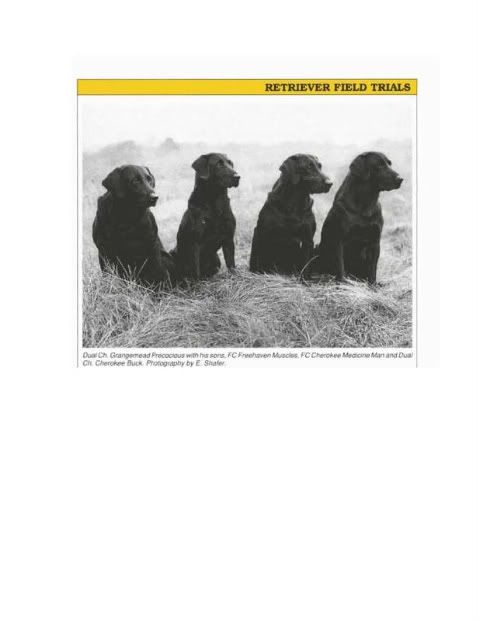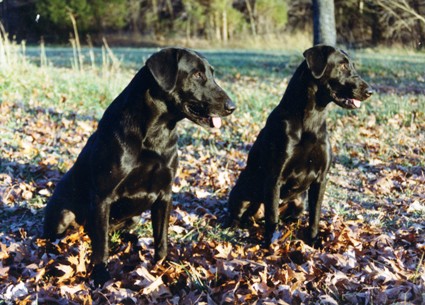A brief reminder. According to all records, Jay Carlisle was responsible for first popularizing the Labrador Retrievers to the U.S. As a matter of fact in the 1950s, the LRC itself recognized him as "singly the most important person responsible for the Labrador's popularity in America."
Jay Carlisle got his first Lab in 1933 and founded Wingan Kennels. To operate the kennel and train the dogs he imported a master dog trainer from Scotland named Dave Elliot. Dave was revered by his peers for his understanding of every element about dogs -- how they think, how they learn, how they work, how they should look. (Trivia: It was Elliot that introduced whistling and handling to retriever trials).
Three years later Elliot wrote and Carlisle published a book called The Labrador Retriever. The book contains four short chapters and is illustrated with photos of the champion Labradors of the time. The first chapter is the breed standard. The second chapter are some insights into training the breed. The third chapter is a presentation on why there should never be a split in the breed between dogs used for trials and dogs used just for hunting. The final chapter is advice to judges for finding the best dogs at trials.
So what can we extrapolate so far. The Labrador Retriever was, is, and always was intended to be a WORKING animal. That was their function.
Form follows function. When the football coach needs someone to protect his quarterback, he looks for a very big, strong man. When he looks for a running back, he looks for someone with speed and quickness. Similarly when beauty contest judges are looking for a winner, they look for exaggerated beauty features like big toothy smiles, large breasts, slim waist and toned legs.
According to Richard Wolters in his book Duck Dogs the split in the breed between field and show began in the late 1950s and early 1960s, when the guardianship of the conformation side of the breed was turned over to people who paid lip service to the working side but had no actual involvement, in particular Helen Warwick. Under her powerful tutelage as the breed columnist for twenty years of the AKC Gazette, the show side of the breed became anglophiled -- enamored with how British show Labs (the split had already occurred over there) looked, importing studs and dams from England, and importing judges from England to judge at Labrador specialties.
So what do we take from this? When the function of the Lab became winning conformation shows (read "beauty contests") those fanciers moved the form of the Lab to accommodate that function. It was the show side that derivated from the original breed type, not the field side.
And so now I show you scans from Carlisle's and Elliot's book The Labrador Retriever.
Jay Carlisle got his first Lab in 1933 and founded Wingan Kennels. To operate the kennel and train the dogs he imported a master dog trainer from Scotland named Dave Elliot. Dave was revered by his peers for his understanding of every element about dogs -- how they think, how they learn, how they work, how they should look. (Trivia: It was Elliot that introduced whistling and handling to retriever trials).
Three years later Elliot wrote and Carlisle published a book called The Labrador Retriever. The book contains four short chapters and is illustrated with photos of the champion Labradors of the time. The first chapter is the breed standard. The second chapter are some insights into training the breed. The third chapter is a presentation on why there should never be a split in the breed between dogs used for trials and dogs used just for hunting. The final chapter is advice to judges for finding the best dogs at trials.
So what can we extrapolate so far. The Labrador Retriever was, is, and always was intended to be a WORKING animal. That was their function.
Form follows function. When the football coach needs someone to protect his quarterback, he looks for a very big, strong man. When he looks for a running back, he looks for someone with speed and quickness. Similarly when beauty contest judges are looking for a winner, they look for exaggerated beauty features like big toothy smiles, large breasts, slim waist and toned legs.
According to Richard Wolters in his book Duck Dogs the split in the breed between field and show began in the late 1950s and early 1960s, when the guardianship of the conformation side of the breed was turned over to people who paid lip service to the working side but had no actual involvement, in particular Helen Warwick. Under her powerful tutelage as the breed columnist for twenty years of the AKC Gazette, the show side of the breed became anglophiled -- enamored with how British show Labs (the split had already occurred over there) looked, importing studs and dams from England, and importing judges from England to judge at Labrador specialties.
So what do we take from this? When the function of the Lab became winning conformation shows (read "beauty contests") those fanciers moved the form of the Lab to accommodate that function. It was the show side that derivated from the original breed type, not the field side.
And so now I show you scans from Carlisle's and Elliot's book The Labrador Retriever.







